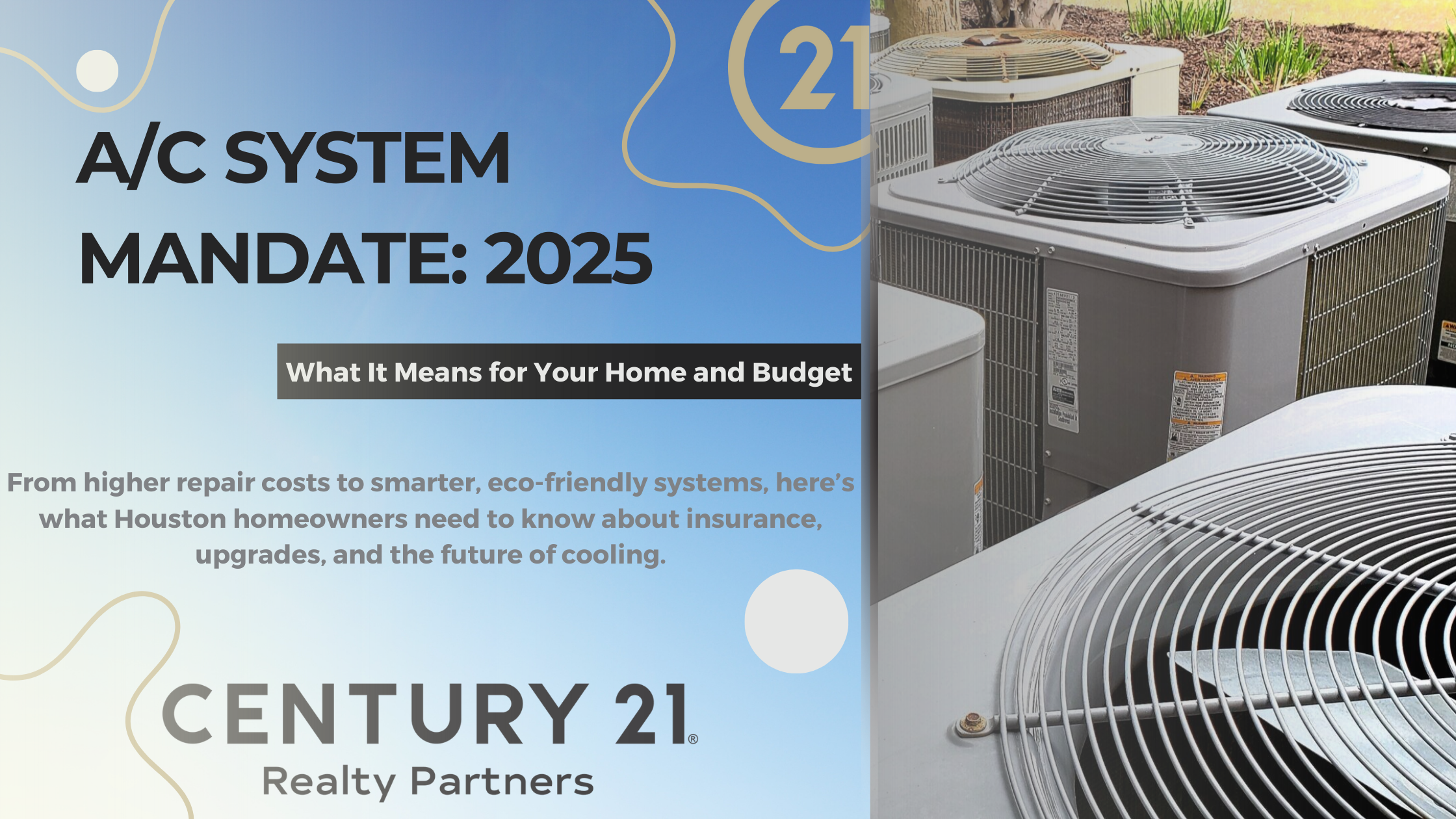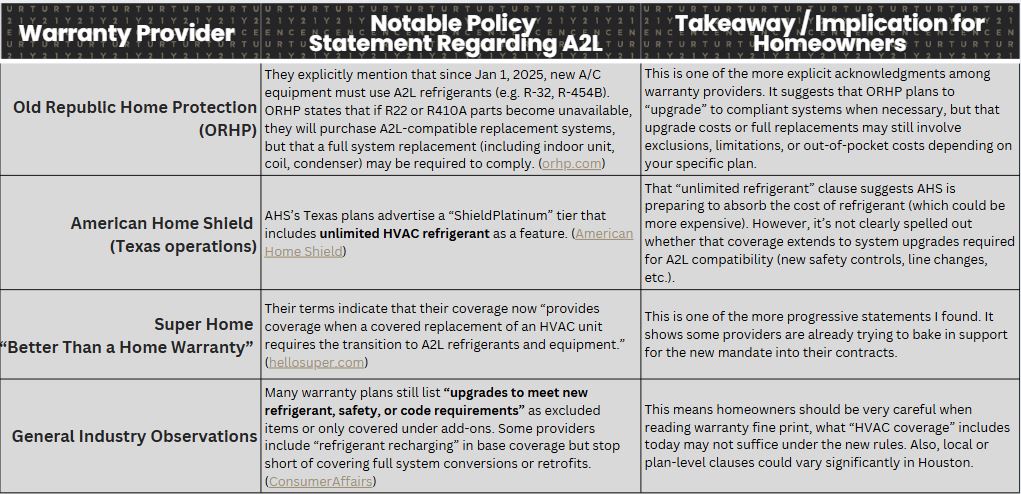Starting January 1, 2025, the EPA mandated that new air conditioning and heat pump systems must not use high-GWP (Global Warming Potential) refrigerants like R-410A. While this may sound technical, the changes affect real-world things like system costs, insurance, and your monthly energy bills. Here’s what Houston homeowners should know, and how to prepare.
What’s Behind the Mandate
R-410A, this refrigerant is the chemical that flows inside your air conditioning system to absorb heat from inside your home and release it outside, keeping your home cool. You may know the older types by their trade names: Freon (phased out in 2010 for damaging the ozone layer) and Puron (R-410A), the current standard.
Under the new rules, systems must comply with a GWP limit of about 700 or lower, ushering in the era of A2L refrigerants, specifically R-454B and R-32. These newer refrigerants are more eco-friendly but mildly flammable, requiring updated safety features in new systems.
Why Is This Happening?
This mandate is part of a broader effort under the American Innovation and Manufacturing (AIM) Act and the global initiative to combat climate change. Enacted in 2020, the AIM Act empowers the EPA to phase down hydrofluorocarbons (HFCs); potent greenhouse gases widely used in air conditioning, refrigeration, and more. The goal is an 85% reduction in HFC production and consumption by 2036.
Older refrigerants like R-410A have significantly higher GWPs, so shifting to alternatives reduces the environmental footprint of our homes. The HVACR industry also stands to benefit from investments in next-generation technology, which may drive job growth, boost U.S. manufacturing, and create export opportunities.
What Does This Mean for Homeowners Today?
If your air conditioner is still running on R-410A, there’s no need to panic, your system is fully functional and can continue to be maintained and repaired. However, because R-410A is being phased out, repairs may become more expensive over time as supply decreases. Planning ahead can help homeowners avoid surprise costs and ensure a smoother transition to the new standard.
For those looking to install a new system, units built for 2025 and beyond will use A2L refrigerants, which are more environmentally friendly but come with added safety features such as leak detectors and automatic shut-offs. These features increase installation costs by 10% – 25%, and limited availability of A2L-compatible equipment may lead to short-term delays or price fluctuations. Being proactive with upgrades and scheduling installations early can help homeowners stay ahead of these challenges.
👉 Tip: If your system is more than 10 years old or needs frequent repairs, it may be smarter (and cheaper long-term) to upgrade sooner rather than later.
How This Affects Home Insurance
Most standard homeowners insurance policies cover damage to A/C systems from events like fire, storms, or theft, but they don’t cover routine maintenance or gradual wear-and-tear. Here’s what to know about the new systems:
- Higher replacement costs: New A2L systems are more expensive to install than older R-410A units, which could affect insurance claims if a system fails.
- Safety features: Leak detectors and automatic shut-offs reduce risk of fire or refrigerant leaks, which some insurers may consider when calculating premiums.
- Older systems: Homes with aging R-410A systems may see higher premiums or additional requirements if the system is nearing end-of-life or has known repair challenges.
👉 Pro Tip: Ask your insurer if they recognize A2L refrigerant systems when calculating coverage or premiums.
How Home Warranties Are Adapting
Things you should ask and consider when renewing or shopping for coverage:
- Does the contract explicitly cover full system replacement or retrofit when your current system cannot be converted to A2L?
- Will you be responsible for the upgrade portion i.e. safety controls, new lines, or parts required for compliance?
- Does “unlimited refrigerant” or “no cap on refrigerant” truly include A2L refrigerants?
- Are there plan tiers (Gold, Platinum, etc.) that incorporate broader refrigerant or retrofit coverage?
- Does the contract include local Texas or Houston code/compliance language (i.e. “meets all applicable local HVAC codes”)?
Positive Impacts on Energy Use
While the mandate may feel like an added expense, new systems are designed to use electricity more efficiently. Updated refrigerants transfer heat more effectively, meaning your A/C doesn’t have to run as long or as hard. When paired with smart technology (sensors, programmable controls, and apps) many homeowners will see lower monthly energy bills.
Heat pumps and hybrid systems add another layer of savings, offering highly efficient heating during Houston’s mild winters without the heavy electric load of older systems. Over time, these upgrades not only reduce your carbon footprint but also make your home more comfortable and budget-friendly.
What Homeowners Can Do to Stay Ahead
The best way to prepare is to start with regular maintenance. Even if your system still uses R-410A, seasonal tune-ups keep it running efficiently, help prevent surprise breakdowns, and can even extend its lifespan. Think of it like getting an oil change for your car, small checkups now prevent big repair bills later.
Homeowners should also consider the age and condition of their system. Units over 10 years old, or those that require repeated repairs, may be better off replaced with new, compliant models. While upfront costs are higher, the long-term savings on energy bills, reduced repairs, and avoiding rising R-410A costs make it a smart investment.
Another way to stay ahead is by tapping into available rebates and incentives. Programs like HOMES and HEAR, along with local utility incentives, can help offset the cost of high-efficiency heat pumps, electrification projects, smart thermostats, and professional tune-ups.
Finally, work with the right HVAC partner. A2L refrigerants are mildly flammable, so technicians need updated training and safety knowledge. Ask if your contractor is certified for A2L systems to ensure correct and safe installation.
Trusted HVAC Companies in Houston
Choosing the right HVAC company is key to staying cool and compliant. Luckily, the Houston Chronicle’s “Best of the Best” readers’ choice poll makes the decision easier. Every year, the readers’ choice poll recognizes the top businesses across the city. Consumers nominate their favorite local companies, votes are tallied, and the Chronicle publishes the winners and finalists. To make the list even more helpful, Hearst’s “Best of” Curators also feature the top two nominees, rounding it out with the top five merchants in each category.
That means when you’re looking for an HVAC company to service, repair, or upgrade your system, you can turn to this list knowing it reflects the voice of Houston homeowners themselves. The Chronicle’s Best HVAC Companies in Houston list offers a trustworthy starting point to connect with skilled professionals who already have the community’s stamp of approval. Here are the top 3:
- 68 Degrees HVAC – Recognized as a “Best of the Best” winner, specializing in efficient installations and indoor air quality solutions.
- John Moore Services – A long-time Houston favorite offering HVAC and full home services with flexible financing.
- Vibrant Mechanical – Known for reliable service, honest pricing, and customer-focused support.
👉 Explore Houston’s Best HVAC Companies here
Questions Buyers Should Ask About the HVAC System
If you’re buying a home, it’s important to dig into the HVAC details before making a decision:
- What type of refrigerant does the system use? Is it older R-410A or a new A2L-compatible unit?
- How old is the system? Units over 10 years may need replacement soon.
- Has it been maintained regularly? Request maintenance records.
- Are there any warranties or service agreements? Knowing what’s covered can prevent unexpected expenses.
- Will insurance cover replacement costs for higher-priced A2L systems?
Asking these questions helps you avoid surprises, plan for potential upgrades, and ensure both comfort and coverage align with the home you’re purchasing.
What to Expect Next: Changes Coming Down the Line
Homeowners will notice a growing adoption of heat pumps and hybrid systems. Today’s models are efficient, reliable, and well-suited for Houston’s climate. Hybrid systems combine electric efficiency with gas backup, offering year-round comfort without high energy bills.
Another upcoming change is the gradual reduction of R-410A supply. Prices are expected to rise, and repairs for older systems could increase 20% – 40% over the next decade. Planning ahead can help homeowners avoid surprise costs.
Finally, A/C systems are becoming smarter and more connected. New units feature sensors, automated controls, and connectivity for apps that track performance, alert homeowners to issues, and optimize energy use, helping keep homes comfortable while lowering utility costs.
Final Takeaway
The 2025 A/C mandate is more than a regulation, it’s a chance to make your home more efficient, eco-friendly, and comfortable. By planning ahead, exploring rebates, and partnering with a trusted HVAC professional, you can future-proof your investment and keep your home cool with confidence. At C21 Realty Partners, we’re here to help you navigate these changes, whether maintaining your current system, planning an upgrade, or buying your next home.
Contact us today to start your journey:
💻 Contact@C21RealtyPartners.com
👉 C21RealtyPartners.com
📞 281-252-4122



This is great information and every homeowner should be aware. It allows for great planning for future maintenance.